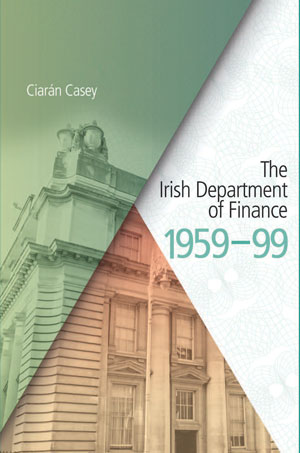THE IRISH DEPARTMENT OF FINANCE 1959–99
Published in Book Reviews, Book Reviews, Issue 1 (January/February 2023), Reviews, Volume 31CIARÁN CASEY
Institute of Public Administration
€35
ISBN 978910393437
Reviewed by Felix M. Larkin
Felix M. Larkin is a historian and a former official of the Department of Finance.
When Ronan Fanning was writing his history of the Department of Finance in the 1970s, someone remarked that its opening sentence should be: ‘In the beginning was the word, and the word was No’. That neatly captured the Department’s miserly image in the period covered by Fanning’s study, 1922–58. Even T.K. Whitaker, the revered Secretary of the Department in the years 1956–69, characterised what he called ‘the Finance attitude’ as one of ‘inverted Micawberism’—that is, ‘waiting for something to turn down’.
All this appeared to change with the publication in late 1958 of the so-called ‘Grey Book’, Economic Development, prepared by the Department of Finance at the instigation of the aforementioned Whitaker. It is generally credited with kick-starting the modernisation of the Irish economy. It is the starting point for this latest instalment in the history of the Department, written by economic historian Ciarán Casey. Casey’s study concludes with the introduction of the euro in 1999.
The Grey Book was, however, less of a watershed than is sometimes claimed. As Casey points out, the winds of change had been blowing for some time beforehand and the Grey Book was actually the culmination of a process that had been under way since the late 1940s. The Industrial Development Authority was established in 1949 and tax relief to encourage exports—the precursor of our low rate of corporation tax—was introduced in 1956. What the Grey Book did was to adopt for the first time a structured, coordinated approach to economic planning in Ireland and it enabled the Department of Finance ‘to seize the initiative on economic policy’ (to quote Casey).
The Department’s commitment to economic planning was short-lived. The first Programme for Economic Expansion, based on the Grey Book, was followed by two others in 1963 and 1969, both of which Casey dismisses as damp squibs. The attempt to produce a fourth Programme was quietly abandoned in the mid-1970s. When the economic planning function was subsequently outsourced to a new Department of Economic Planning and Development in 1977, Finance set out to strangle that Department at birth—and it was abolished by C.J. Haughey when he became taoiseach in 1979.
The figure of Haughey looms large in this study. He was Minister for Finance from 1966 to 1970, and was later proactive in setting the economic agenda during his three terms as taoiseach. Casey notes that, notwithstanding his blatant political opportunism and profligacy with the public finances, he was highly regarded in the Department for his sheer ability. Anyone hoping that Casey’s research would throw light on the Arms Crisis that led to Haughey’s sacking in May 1970 will, however, be disappointed. Casey repeats the suggestion made by others that the relevant files may have been ‘heavily pruned by those involved’.
From 1979 onwards, the Department of the Taoiseach became increasingly involved in the minutiae of economic policy. Haughey and Garret FitzGerald began this trend as they alternated as taoiseach during the 1980s, and it continued under their successors. Finance was not in a position to resist, and its writ was narrowed further by the removal of the state’s borrowing operations to the National Treasury Management Agency (NTMA) in 1991. Moreover, Ireland’s accession to the European Economic Community (EEC)—now the European Union (EU)—in 1973 had given the Department of Foreign Affairs a voice in economic affairs. It would be an exaggeration to say that the Department of Finance was thus reduced to its traditional role of the nation’s bookkeeper, but by 1999—the end date of this study—its position as primus inter pares among government departments in policy matters had been seriously eroded.
Why did Finance lose out in the bureaucratic struggle for power and influence? Casey suggests that the lack of professional economic expertise, which was highlighted in the Wright report on the Department after the banking crisis of 2008, weakened its authority. A further factor was the steady loss of talented people to more remunerative employment in semi-state and international bodies and the private sector. A more fundamental problem was that politicians confronted by the incessant demands of the electorate for increased expenditure and reduced taxation were simply unwilling—indeed, unable—to accept the advice proffered by the Department. At least one Minister for Finance is known to have reminded his officials that they did not have to face an election in order to hold on to their jobs.
Dr Casey has written a succinct but comprehensive account of the Department of Finance over an eventful period in Ireland’s history, based on exhaustive research in the voluminous records of the Department. It is essential background reading for those who wish to study any aspect of Irish politics and society in the recent past. And he leavens the gravity of his subject with some delightfully humorous chapter and section headings—for instance, his chapter on the period of ascendency of Haughey and FitzGerald is titled ‘Castor and Pollux’, and a section on the culture of confidentiality within the Department is headed ‘Omertà’. The Department of Finance is to be commended on breaking its code of silence and opening its files first to Ronan Fanning in the 1970s and now to Ciarán Casey.

















